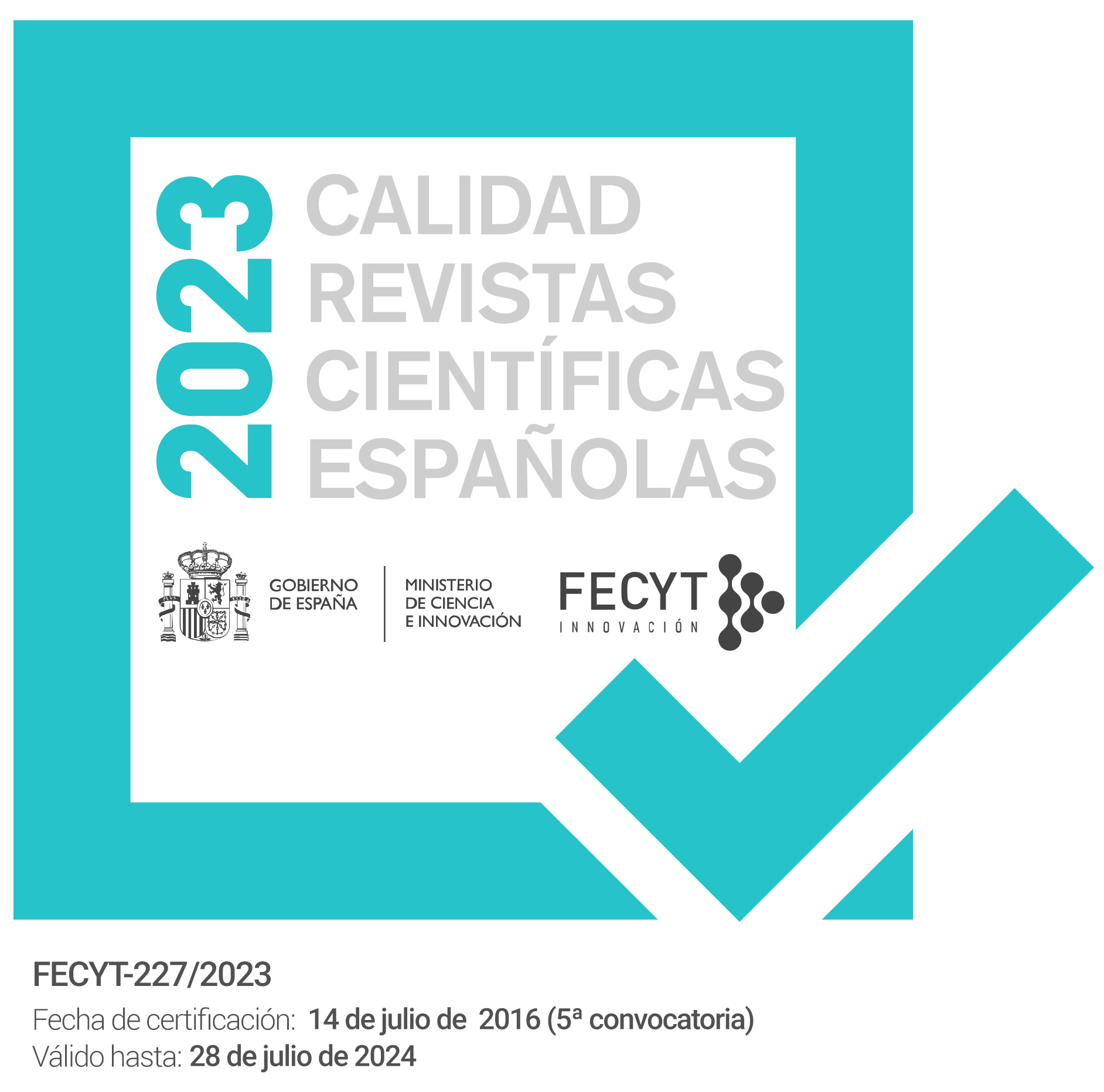Síntesis y caracterización de nuevas macromoléculas dextran-conjugadas de aceclofenac
Palabras clave:
Aceclofenaco, profármaco polimérico, dextrano, índice de úlcera, histología patológicaResumen
El estudio se centra en la condensación de acilimidazoles derivados de aceclofenaco (AC) con dextrano 10.000 y 20.000 para obtener los profármacos de aceclofenaco-dextrano AC10 y AC20, respectivamente, con el objetivo de mejorar la hidrosolubilidad, aumentar la eficacia terapéutica y reducir los efectos secundarios gastrointestinales. La estructura de los profármacos sintetizados se ha confirmado a través de espectroscopia IR y RMN. El peso molecular ha sido determinado a través de la ecuación de Mark-Houwink-Sakurada y se ha obtenido un grado de sustitución de 13,3 y 16% para los profármacos. La hidrólisis in vitro llevada a cabo en fluido gástrico simulado (FGS), fluido intestinal simulado (FIS) y fluido colónico simulado (FCS) ha mostrado una hidrólisis más rápida en FIS y FCS. De ello ha resultado un porcentaje de actividad antiinflamatoria de AC de 49,56, mientras que para AC10 y AC20 se ha obtenido un valor aumentado de 56,44 y 61,82% respectivamente. Los profármacos han mostrado una mejor analgesia y una menor ulcerogenicidad que el aceclofenaco, por lo que se demuestra que su acción es mejor que la del fármaco base.Descargas
Citas
Parfitt K. Martindale: The complete drug reference, 32nd ed. London: Pharmaceutical Press, 1999.
Kay AE, Alldred A. Clinical pharmacy and therapeutics, 3rd ed., London: Churchill Livingstone, 2003.
Lee JS, Jung YJ, Doh MJ, Kim YM. Synthesis and properties of dextran – nalidixic acid ester as a colon specific prodrug of nalidixic acid. Drug Dev Ind Pharm. 2001; 27(4): 331-336.
Onishi H, Machida Y. In vitro and in vivo evaluation of microparticulate drug delivery systems composed of macromolecular prodrugs. Molecules. 2008; 13: 2136-2155.
Zovko M, Zorc B, Novak P, Tepes P, Cetina-Cizmek B, Horvat M. Macromolecular prodrugs XI. Synthesis and characterization of polymer-estradiol conjugate. Int J Pharm. 2004; 285 (1-2): 35–41.
Chourasia MK, Jain SK. Pharmaceutical approach to covalent target drug delivery systems. J Pharm Pharm Sci. 2003; 6(1): 33-66.
Arun R, Aishwarya K, Niyaz B, Sravya B, Swetha A. Ibuprofen-dextran polymeric prodrugs: synthesis, characterization and pharmacological evaluation. Der Pharma Chemica. 2009; 1(2): 124-132.
Vyas S, Trivedi P, Chaturvedi SC. Ketorolac-dextran conjugates: synthesis, in vitro and in vivo evaluation. Acta Pharm. 2007; 57(4): 441–450.
Penugonda S, Kumar A, Agarwal HK, Parang K, Mehvar R. Synthesis and in vitro characterization of novel dextran-methylprednisolone conjugates with peptide linkers: effects of linker length on hydrolytic and enzymatic release of methylprednisolone and its peptidyl intermediates. J Pharm Sci. 2008; 97(7): 2649–2664.
Arun R, Sathish Y, Sravanthi VVNSS, Vamsikrishna K, Theja I. Design, hydrolysis and pharmacological evaluation of novel polymeric prodrugs of Etodolac. Der Pharmacia Lettre. 2009; 1(2), 9-17.
Van Der Merwe T, Boneschans B, Zorc B, Breytenbach J, Zovko M. Macromlecular prodrugs: X. Kinetics of fenoprofen release from PHEA-fenoprofen conjugate. Int J Pharm. 2002; 241(2): 223–230.
Larsen C. Dextran prodrugs-sructure and stability in relation to therapeutic activity. Adv Drug Deliv Rev. 1989; 3(1): 103–154.
Fieser M. Fieser and Fieser’s reagents for organic synthesis. Vol. 11, New York: Wiley Interscience, 1983.
Misra GS. Introductory polymer chemistry. 1st ed., New Delhi: Wiley Eastern Ltd, 1993.
Winter CA, Risley EA, Nuss GW. Carregeenan induced oedema in hind paw of the rat as assay for anti-inflammatory drugs. Proc Soc Exp Biol Med. 1962; 111: 544-547.
Khan MSY, Khan RM. Synthesis and biological evaluation of glycolamide esters as potential prodrugs of some non-steroidal anti-inflammatory drugs. Ind J Chem B. 2002; 41B (10): 2172-2175.
Davies OL, Raventos J, Walpole AL. A method for the evaluation of analgesic activity using rats. Br J Pharmacol Chemother. 1946; 1(4), 255-264.
Shanbhag VR, Crider AM, Gokhale R, Harpalani A, Dick RM. Ester and amide prodrugs of ibuprofen and naproxen: synthesis, anti-inflammatory activity and gastrointestinal toxicity. J Pharm Sci. 1992; 81(2): 149-154.
Yagmurca M, Ucar M, Fadillioglu E, Erdogan H, Ozturk F. The effects of nitric oxide on rat stomach injury induced by acetylsalicylic acid. Turk J Med Sci. 2009; 39(1): 13-19.
Descargas
Publicado
Cómo citar
Número
Sección
Licencia
Los artículos que se publican en esta revista están sujetos a los siguientes términos en relación a los derechos patrimoniales o de explotación:
- Los autores/as conservarán sus derechos de autor y garantizarán a la revista el derecho de primera publicación de su obra, la cual se distribuirá con una licencia Creative Commons BY-NC-SA 4.0 que permite a terceros reutilizar la obra siempre que se indique su autor, se cite la fuente original y no se haga un uso comercial de la misma.
- Los autores/as podrán adoptar otros acuerdos de licencia no exclusiva de distribución de la versión de la obra publicada (p. ej.: depositarla en un archivo telemático institucional o publicarla en un volumen monográfico) siempre que se indique la fuente original de su publicación.
- Se permite y recomienda a los autores/as difundir su obra a través de Internet (p. ej.: en repositorios institucionales o en su página web) antes y durante el proceso de envío, lo cual puede producir intercambios interesantes y aumentar las citas de la obra publicada. (Véase El efecto del acceso abierto).



















